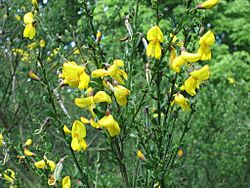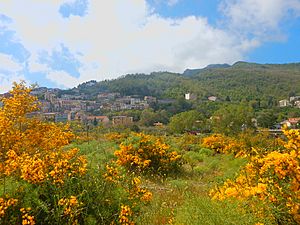Broom (shrub) facts for kids
Quick facts for kids Broom |
|
|---|---|
 |
|
| Common Broom, Cytisus scoparius | |
| Scientific classification | |
| Kingdom: | |
| Division: | |
| Class: | |
| Order: | |
| Family: | |
| Subfamily: | |
| Tribe: |
Genisteae
|
| Genera | |
|
|
Brooms are a type of shrub that can be evergreen (keeping leaves all year), semi-evergreen (keeping some leaves), or deciduous (losing leaves in winter). These plants are known for their many slender, green stems.
You can find brooms and their relatives, like Laburnum and Ulex, in Europe, north Africa, and southwest Asia. The most different kinds of brooms grow around the Mediterranean Sea. Many brooms can regrow after fires. Their roots survive, and seeds stored in the soil sprout easily after a fire.
The most well-known type is the common broom. It grows in northwestern Europe. You often see it in sunny places, especially on dry, sandy ground. Like most brooms, it has stems that look like they don't have many leaves. In spring and summer, these stems are covered with bright golden-yellow flowers. Later in summer, its seed pods, which look like pea pods, burst open. You can often hear a small pop as they spread their seeds. Common broom usually grows about 1 to 3 meters tall, but can sometimes reach 4 meters. It is also the toughest broom, able to survive cold temperatures down to about -25°C.
Contents
Broom Plant Family
Brooms belong to the Fabaceae family, also known as the legume family. They are part of a group called Faboideae. Most brooms are found in three main genera: Chamaecytisus, Cytisus and Genista. There are also five other smaller groups of brooms. All these groups are closely related. They share features like thin, green stems and very small leaves. These features help them survive in dry places. Most brooms have yellow flowers, but some have white, orange, red, pink, or purple flowers.
Brooms as Invasive Plants
In some parts of the world, brooms have become a problem. For example, on the east and west coasts of North America, common broom (Cytisus scoparius) was brought over as a plant to make gardens look nice. This started in California around the 1860s. In many areas, it is now known as Scotch broom. It has become an invasive weed. This means it spreads very fast and takes over areas where native plants used to grow. Because its seeds spread so easily, it's very hard to get rid of.
Similarly, brooms are a big problem in the cooler, wetter parts of southern Australia and New Zealand. Scientists have been looking for ways to control brooms in New Zealand since the mid-1980s. On the west coast of the United States, French broom (Genista monspessulana), Mediterranean broom (Genista linifolia), and Spanish broom (Spartium junceum) are also considered harmful invasive plants. They quickly push out native plants and often grow in places that are hard to reach.

Broom in Folklore
There's an old saying from Sussex that goes: "Sweep the house with blossed broom in May/sweep the head of the household away." This rhyme suggests that using broom flowers for sweeping in May might bring bad luck to the head of the family.
However, broom was also used in positive ways. It was common to include a decorated bunch of broom at weddings. People also used the ashes of broom to help treat dropsy, a condition where the body swells. Some even believed that the strong smell of broom could help calm wild horses and dogs.
Gallery
-
Common broom (Cytisus scoparius).
Images for kids
-
Cytisus scoparius, Common Broom. This image shows different parts of the plant: 1. The calyx (outer part of the flower). 2. The standard petal. 3. One of the wing petals. 4. The keel petal. 5. The stamens (male parts). 6. The ovary (female part) with its style. 7. The seed pod.
See also
 In Spanish: Cytisus scoparius para niños
In Spanish: Cytisus scoparius para niños







